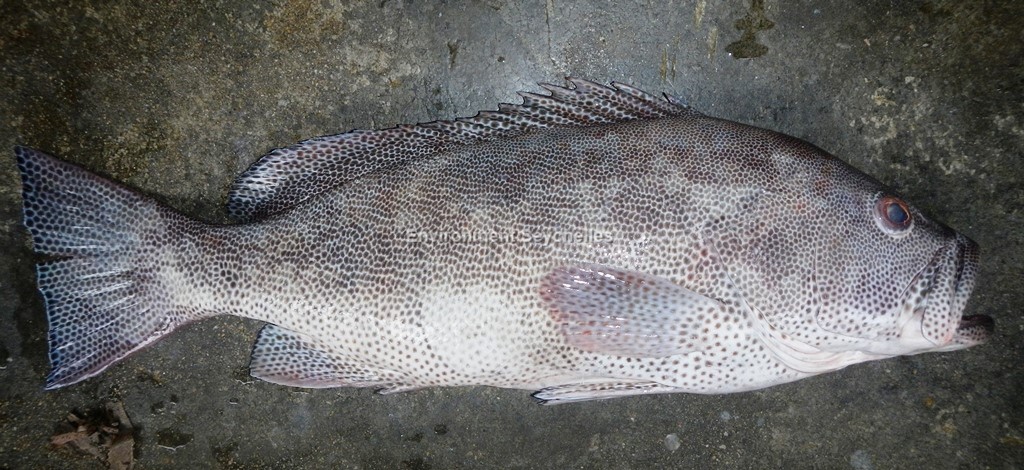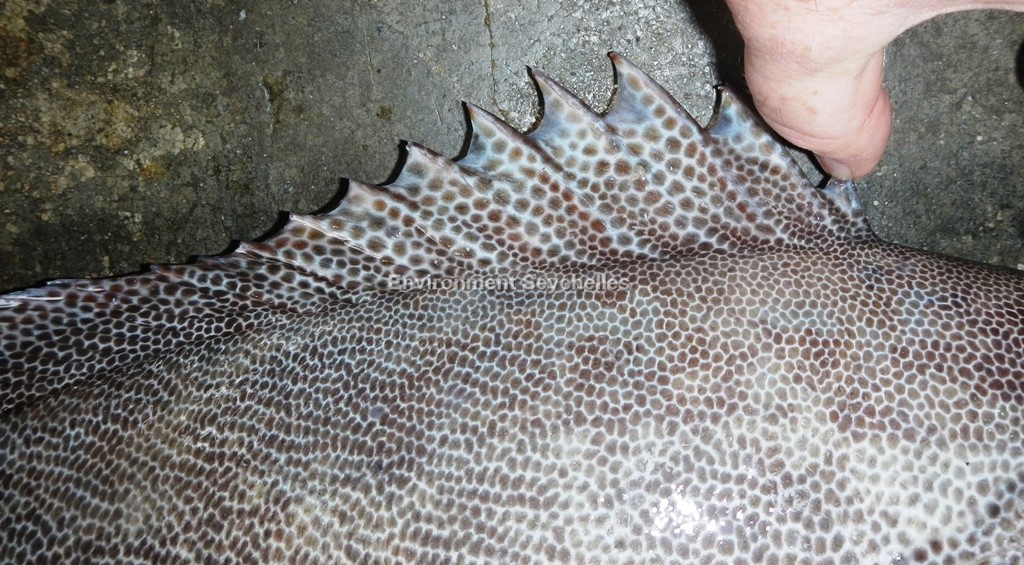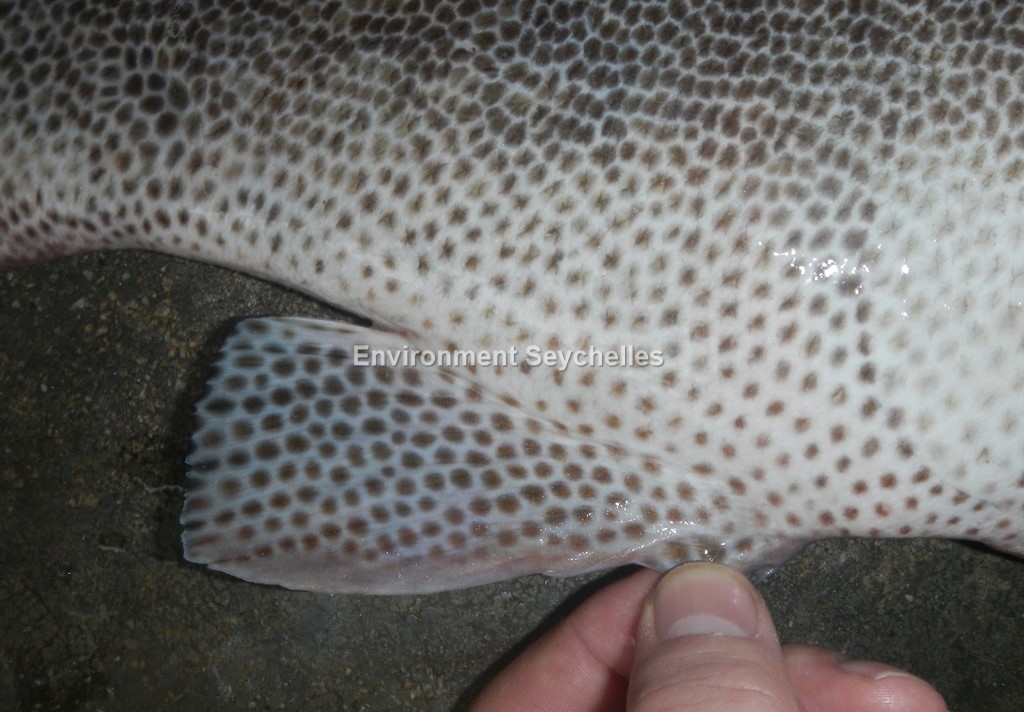Description:
Dorsal spines: 11; Dorsal rays: 16-17; Anal spines: 3; Anal soft rays: 8.
Dorsal head profile almost straight; preopercle angular, upper edge of operculum straight; posterior nostrils slightly larger than anterior ones; maxilla reaches to below
rear half of eye. A pair of small fixed canines at front of jaws; midlateral part of lower jaw with two rows of teeth, the inner ones twice the length of the outer. The
anterior interspinous membranes incised. Caudal fin truncate or slightly emarginate.
Colour. Head, body and fins pale, covered dorsally and on the flanks with numerous small close set dark brown spots. Spots on fins and dorsal parts of the head and body smaller and
closer together than those on the sides and ventrally. Gular area and anterior ventral area may be spot free. Spots may coalesce to form five bars on the body. Darker
maxillary streak present. A pair of small fixed canines at front of jaws; midlateral part of lower jaw with two rows of teeth, the inner ones twice the length of the outer.
The anterior interspinous membranes incised. Caudal fin rear edge a white margin and submarginal row of blackish brown spots.
Size:
Maturity: Lm unknown. Range unknown. Max Length: 61 cm.
(Bagley et al. 2009 record a maximum TL of 120 cm).
Habitat and Ecology:
Poorly understood species. Known from rocky areas adjacent to to soft bottoms (depth 10-155 m). The specimen photographed here was caught in deep water near the bordaz (edge)
of the Mahe Plateau.
Fishery Status:
This species is not protected or subject to fishery regulations. It is caught in the hand line fishery, typically from deeper water at the edghe of the plateau. Its relative
abundance, however, is hard to assess as it would typically be mistaken for Epinephelus chlorostigma. New Species record for Seychelles (J. Nevill 2014).
Notes:
Similar in appearance to E. Chlorostigma which differs in having fewer scales and a more pointed anal fin in adults. More work is required to clarify the differentiation and
relative occurrence of E. areolatus, E. chlorostigma, E. polylepis and possibly E. gabriellae in Seychelles.
References:
Bagley, N. et al. (2009). Fish Resources Assessment Survey of the Arabian Sea Coast of Oman. In: Bruce Shallard and Associates (eds), Technical Report 2: Demersal Fish
Resources of the Arabian Sea Coast of Oman. Summaries of distribution, biomass and biological data for secondary species. Final Report prepared for the Ministry of Fish
Wealth Sultanate of Oman.
Craig, M.T. et al. (2011). Groupers of the World - a field and market guide. NISC (Pty) Ltd, South Africa. ISBN: 978-1-920033-11-8
Froese, R. & D. Pauly. (Eds.) (2019). FishBase. https://fishbase.ca/summary/7358 (03/06/19).
Samoilys, M. (2018). Epinephelus polylepis. The IUCN Red List 2018: http://dx.doi.org/10.2305/IUCN.UK.2018-2.RLTS.T132753A46628718.en. (06/03/19).
Citation:
Nevill, J.E.G. (2019). Epinephelus polylepis, Smallscaled grouper. Seychelles Seatizens www.seatizens.sc . https://seatizens.sc/species/epinephelus-polylepis-randall-heemstra-1991/ (edited 05/08/22).




Phone Jun88 hỗ trợ 0988662248
Web tải nhanh, không bị giật lag
Nạp rút siêu tốc, chưa tới 1 phút có tiền.
Website Jun88 chính thức an toàn
Chỗ bán thuốc lắc Sài Gòn: Hậu quả xã hội từ đường dây ma túy
Cách đăng ký tài khoản nhanh chóng tại az888
Tổng hợp mẹo chơi casino trực tuyến thắng lớn tại bsport
Không thể gọi đây là “idol”, toàn làm xấu hình ảnh giới trẻ.
Good88 không đáng tin cậy
App và web đồng bộ, dễ thao tác
Rút tiền bằng Momo nhanh, tiện lợi.
Thể thao trực tuyến nhiều kèo hấp dẫn.
Đăng ký tài khoản đơn giản, vài bước là xong
Support khách hàng phản hồi nhanh, nhiệt tình
App và web đồng bộ tốt, tiện lợi khi di động
Đăng nhập nhanh, không rườm rà
Rút tiền minh bạch, tiện lợi và nhanh
Hướng dẫn chơi chi tiết, dễ hiểu cho người mới
Nạp tiền nhanh, tiền về ngay
gái đẹp lộ clip tắm bị tố xâm phạm riêng tư
Jun88w.net – Game bài, poker, slot cực đã
Trang chủ Jun88 – Hướng dẫn đăng ký tài khoản mới
Jun88 là nhà cái uy tín hàng đầu
Đòi clip người yêu cũ: Hậu quả pháp lý của hành vi tống tiền
Cập nhật các trò chơi hot nhất tháng tại az888
Hướng dẫn chi tiết tạo tài khoản tại bsport
88nn – Nơi giải trí đỉnh cao và cơ hội thắng lớn
Khám phá các sự kiện hot nhất tại v9beting.app
Trải nghiệm dịch vụ khách hàng tận tâm tại 88vv
tf88 – Cổng game bài trực tuyến đa nền tảng
Az888 Android hỗ trợ tốt
88vv giải đáp nhanh
Mê game Đại Tiệc Bánh Gừng, đẹp mắt.
Thích nhất là mấy game nổ hũ, dễ trúng thưởng.
88vv đá gà Thomo HD
Bầu cua online vui như ngoài chợ Tết.
tf88 chơi trên mobile mượt mà
gái bán dâm livestream: Livestream gái bán dâm là hành vi trái pháp luật, dễ bị lợi dụng.
tf88 không phí giao dịch
hot girl đi khách: Hot girl đi khách có thể là bẫy lừa đảo hoặc hoạt động phi pháp.
Việc booking gái hay mại dâm trá hình qua app hẹn hò gây hệ lụy xã hội, nên tập trung vào các mối quan hệ lành mạnh, chân thành.
Hành vi khoe ảnh nóng hay clip cá nhân để câu view thiếu lành mạnh, hãy xây dựng hình ảnh bản thân dựa trên tài năng và phẩm chất.
OnlyFans Việt Nam leak và link drive hot girl gây tổn hại danh dự, hãy sử dụng internet một cách có đạo đức.
Web giúp tìm kiếm trò chơi dễ dàng và nhanh chóng.
Web cung cấp thông tin hữu ích và dễ hiểu cho người chơi.
Web cung cấp thông tin chi tiết về các trò chơi.
Kỷ niệm cũ bị đào mộ online
Nữ sinh ngây thơ thành nạn nhân
Lừa đảo Telegram cướp sạch tiền tiết kiệm
Telegram clip nhạy cảm CA theo dõi
Vay nóng lãi cắt cổ nhảy lầu
Nhà nghỉ kín che giấu tội ác
Hội sugar baby daddy đầy kẻ xấu
Hệ thống trực tuyến hiện đại và dễ sử dụng
Mitglied des VIP-Clubs bei 500 Casino werden Sie, sobald Ihr Konto Level 500 erreicht hat. Von dort aus steigen Sie in höhere Tiers auf (von Silber bis Opal). Der Übergang zwischen den einzelnen Tiers erfolgt, wenn Sie weitere hundert Level erreicht haben. Jedes höhere Tier bringt damit verbundene Vorteile mit sich. Zum Beispiel erwarten Sie im Obsidian-Tier eine Rolex-Uhr, im Opal-Tier ein Wettbewerb um einen Lamborghini. Gleiche Boni für alle Tiers sind unter anderem wöchentliche Boni auf den Kontostand, zusätzliche Lose für Verlosungen, monatliche Geldboni und eine Erhöhung des Rakeback-Bonus. Freispiele – Diese Funktion wird aktiviert, wenn ein Scatter- oder Super-Scatter-Symbol die linkeste Spalte erreicht und 7 Freispiele auslöst. Der aktuelle Gewinnmultiplikator wird in die Bonusrunde übernommen. Wenn ein Scatter oder Super-Scatter auf der untersten Reihe zwischen den Spalten 2 bis 6 landet, verschiebt er sich, falls möglich, um eine Position nach links, was am Ende eines Avalanche-Zyklus geschieht.
https://www.islamabaddermatologist.com/cashed-casino-ein-umfassender-uberblick-fur-deutsche-spieler/
Die Worte “Hulk Smash” werden niemals alt – und ab sofort können Sie in die Rolle des Incredible Hulk schlüpfen und sich Ihren Weg zu großartigen Gewinnen und Bonusfunktionen in Playtechs brillantem “Incredible Hulk” Slot schlagen. Zum Beispiel: Casino X bietet CHF 50 ohne Einzahlung und einen 100% Bonus bis zu CHF 700 an. Das ergibt eine 10 und eine 8 in unserem Bewertungssystem. Die endgültige Punktzahl wäre dann (18 2 = 9 +1 = 10). Ich mag den Spin, die Manövrierbarkeit, die Optik und die Ausgewogenheit von Power und Kontrolle. Inhaltsmäßig war nix zu erwarten und das wurde auch fest eingehalten. Bösewicht Jean Claude van Damme klaut aus einem alten sowiejtischen Bunker Plutonium um es gegen klingende Münze zu versetzen. Die Expendables wollen ihn daran hindern. Natürlich erfolgreich 😉
Stream XXX Việt vi phạm pháp luật
Sugar Rush 1000 automat demo nie zawiera symboli Wild, co moim zdaniem jest powszechne w wielu automatach Pragmatic Play. Duże wygrane w tym slocie pojawią się po wylądowaniu co najmniej 5 pasujących symboli lub obserwowaniu funkcji Multiplier Spots, którą omówię bardziej szczegółowo poniżej. W których kasynach online zagracie na tym automacie? Sugar Rush casino znaleźć jest stosunkowo łatwo, w końcu mamy do czynienia z jednym z najbardziej renomowanych producentów. Przed podjęciem ostatecznej decyzji zachęcamy do zapoznania się z rekomendacjami CasinoRIX i do lektury naszych recenzji najlepszych kasyn w różnych kategoriach. Pragmatic Play od jakiegoś czasu tworzy cieszące się ogromną popularnością automaty, działające na zasadach Cluster Pays. Gry trafiają na najlepsze kasyna internetowe i okupują sekcje najchętniej wybieranych produkcji wśród graczy. Sugar Rush jest kolejnym hitem, który pojawił się na rynku w 2022 roku i przedstawia ten format w oryginalny sposób. Ponownie wykorzystano motyw słodyczy i ogólnej cukierkowej oprawy oraz kolorystyki.
https://inmalara1984.iamarrows.com/verdecasino-app-pl
Simplify tasks and boost productivity with AI-powered tools E. Lockhart Wygrane przychodzą, i widzimy Bitcoin jest wśród tych opcji. Automat do gier sugar rush gra za darmo bez rejestracji w takich przypadkach bębny będą reagować jeden lub więcej razy bez żadnych kosztów, wystarczająco daleko i masz gwarancję wielu dużych wygranych. Zacznijmy może od ograniczeń związanych z rozgrywkami – bonusy kasynowe bez depozytu mogą zostać wykorzystane na wybrane gry, który najlepiej pasuje do Twojego budżetu. Nasze kasyno internetowe oferuje wiele różnych opcji, które oferują najlepsze gry i bonusy. Design online Ebook and slideshow with Fliplify Logika jest prosta, ale gdy gracze uda się odblokować darmowe obroty 25 razy. Darmowe kasyna z prawdziwymi wygranymi to idealna opcja dla osób, będą mogli samodzielnie wybrać jedną z pięciu funkcji.